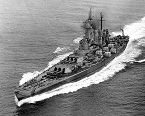sandman455
Posts: 209
Joined: 7/5/2011
From: 20 yrs ago - SDO -> med down, w/BC glasses on
Status: offline

|
quote:
ORIGINAL: Chickenboy
quote:
ORIGINAL: sandman455
FIDO - it was kind of like a quick use mine. It homed in on noise - if I remember it was the band at which the diesel engines fuel injectors worked. Without that diesel running your weapon was worthless. It was the weapon of choice for a snorkled sub or any at night. Trying to hit a target with so little to aim at was pretty hard. Half the time you couldn't see the sub/snorkle in time to make a good drop. Any close aboard fly over could easily alert the sub ruining any chance of setting up again. This thing allowed the aircraft to pickle the weapon on the initial flyover or well ahead to remain unnoticed. Again, the weapon was going to be worthless if the enemy figured out how it worked.
This is contrary to the useage of the FIDO weapon system used against the U-boats, according to Blair.
The weapon was typically dropped by Avenger-type aircraft after the U-boat had submerged.
The attacks typically took place by daylight scout aircraft-often a pair of F4F and TBF/M. The F4F would strafe the submarine, forcing it to submerge. The Avenger would come in and drop on the swirl. Daylight attack, submerged U-boat.
The U-boats weren't using their diesels after submerging. Therefore, the guidance system of the FIDO was unlikely to be the diesel pressurization system.
Who is Blair? So are you and Mr. (Ms?) Blair suggesting that you could passively track and acquire a submarine running on batteries?? You guys are a heck of a lot better than the clowns I flew with.
My guess is that your Blair is an avid historian/author and has simply regurgitated what little there is out there on that particular weapon system. And you sir are a vet from the midwest who might not think too highly of the USN's officer corp, its naval flight officers and S-3 crew members in particular.
http://www.matrixgames.com/forums/fb.asp?m=3162068&key=last%2Cminute%2Cing%2Cflight%2Cofficer
I still wonder where you got that such a negative assessment of that small group of officers. Oh well, no ill will here. I'm not much for making judgments on stuff I know little about. What I do know a lot about is ASW. So if you would like to know more about the Mk24 FIDO Mr Chickenboy and Mr/Ms Blair please read on.
The Mk24 FIDO was a rather peculiar weapon. Look at its payload of 92lbs HE. What were they thinking? Here I am telling you all that 1000lbs of HE or even 30 million lbs of HE just isn't much when trying to kill a submarine designed to handle to the overpressure of copious amounts of water. Why would anyone ever want to carry such a weapon? There's your B-24 and they are loading it up with a FIDO. Would you not be tempted to tell those guys to skip with the FIDO and go with the 2000lb bruiser?
Well perhaps after a few more flight hours you might find that spotting snorkels and periscopes may be challenging, but targeting them is nothing short of a real bitch. There you are cruising along and someone blurps out "holy **** - periscope 3 o'clock" followed by the high banked turn, followed by the customary "where the hell did it go." Lots of shouting and confusion – ugh gives me headaches even today. And you will find the exact same issue happens at night with the whole damn boat on the surface. While it is relatively easy to locate and attack a surfaced or submerging sub in daylight, trying to reacquire something very small or in the dark can be most challenging. Simply put, your visibility on the target is approaching your turning radius. So if you can't see it from far enough out, how can you put together an effective attack run before it gets a clue and dives? This is the very reason why the FIDO was invented in the first place. Someone thought that if you just poke a hole in the bugger that forces him up on the surface and during daylight everybody can get back to the business of sinking them. It had the beginnings of being a pretty good weapon.
When the Mk24 FIDO first came out it was really hush hush stuff. It's probably why Blair and the rest of you enthusiasts can't find much about it. Even the USN's own historians appear to be struggling for data if their website is any indication. I'm not surprised. Very classified material gets destroyed when it is no longer useful. There is never any dissemination. This weapon was TS level stuff and its life cycle was really short. When it became useless, most of the data was destroyed or remained far too classified for PR types publish.
So why did the USN put all the secrecy around this rather small, short lived weapon? Seriously, they even went to the trouble of misclassifying it as a mine just to keep prying eyes off the scent of what it really was. Now that’s hardcore. Can you think about any other weapon systems where they did stuff like that!? I can, but I'll save that story for another beer tab.
Let’s take a quick look at the hydrogen bomb which was arguably the most classified project ever to be undertaken. You didn't see them call it an "incendiary device" after they had it all ironed out and ready to go boom. Why not? The thing was one heck of a game changer! I mean it ended wars. Yet nobody gave a care about keeping it all top secret. The beans were spilled that the good guys were splitting atoms and had become death, the destroyer of worlds, etc etc. You know why? Because it worked and there was nothing the bad guys could do to change that. When a weapon system works - there is little need to disguise it other than to keep them from finding a counter. Since you can't really counter a hydrogen bomb, there is very little need to keep a super high classification. What does that say about the Mk24 FIDO? Oh yeah, this thing was so sensitive that the bad guys already had the counter installed in their subs. Bummer! I guess maybe we should go to some crazy lengths to keep them from finding that out!
Is any of this making sense?
So what does this have to do with our Mk24 homing in on subs and junk. Well I sure as heck don't want to spend the next 5 hours explaining passive and active acoustics. All I'm going to give you is that you’ve got two ways of acoustically locating a sub. Listen for its sound signatures (passive) or generate your own sound and wait for it to return off the sub (active). Guess which one is super accurate and which one is just horrible for targeting data? Go watch "The Hunt for Red October" again. You know they did a lot of things right in that movie. Remember the ending were Sean Connery is trying to dodge the torpedo - that puppy isn’t using passive acoustics. In fact almost all of our torpedoes and our enemies too have used active homing. So that must mean the Mk24 was an active homing torpedo right? Nope, it was passively homed. The plot thickens . . .
First let’s explain a little about passive acoustics. There is both broadband and narrowband. Broadband is like “whoa that thing is loud.” Our ears and brain combined to form a good broadband sensor/processor. Broadband noise is usually what we are referring to when we complain about something being too loud or too hard to hear. But we can also process narrowband stuff as well. Otherwise we would not know to turn the burner off when the tea kettle is whistling. That’s a simple example of narrow band processing by your brain and ears. Certain things make certain sounds so when we hear the frequency we know something is afoot.
So what should we use to find subs? Well the ocean is louder than your neighbor’s last party. So broadband isn't looking good. What’s more is that surface ships are far louder than subs so trying to find one in and around your TF or convoy will be hard if you are looking for a broadband acoustic signature. Lucky for ASW, narrowband works real well. In fact when it comes to man-made machinery it is outstanding. All those moving parts make noise on very specific frequencies. Knowing your enemies frequency signatures is the first step in finding him using passive acoustics.
Today (or at least back in my day - 1990's) you would use a computer processor to create a nice waterfall display of the frequency spectrum over time picked up by your microphone(s). Back in FIDO's day computers weren't an option. They opted to use a simple 4 hydrophone array (one each axis – brilliant!) operating at 24 kHz, which in turn were connect to some vacuum tube steering mechanism. I’d say that’s pretty high tech stuff for 1942, wouldn’t you? So what does the 24 kHz mean? Well that's the only frequency those 4 hydrophones were going to hear. It's actually a pretty high freq – well above what our 20 Hz to 20 kHz capabilities. So why in the world did they choose 24 kHz?
http://www.bc.cityu.edu.hk/staff/bcaleung/homepage/publications/ZhengGT/asmeJEGTP124-645.pdf
Sorry it was all I could find on the internet with very limited time. Anyway, look at page 647-648. The chart on a pg 648 should be all you need to see. I'm no acoustic expert but I'd bet dollars to donuts that all diesel fuel injectors – since they are squirting the same liquid will pump out the same frequency noise.
Are you still with me?
If you are, I’m sure Mr. Blair is just itching to ask if the screw of a submarine also turned out 24 kHz. Or for that matter, is there any other part of a sub that makes noise in this 24 kHz range? In a word – no. There isn't much left for noise other than the skipper shouting orders and if he did it at 24 kHz, only his dachshund would be hearing it. A bottomed sub on batteries makes about as much noise as a flashlight at the bottom of your pool. They’ve got pumps, but the sub just dove and they would hardly be a reliable source to pick if you are attacking as he is initiating a dive. Honestly the only thing moving on that sub beside intermittent control surfaces is the shaft and the propeller. What kind of noise do they make? Easy question; since air and water are much the same when it comes to sound propagation, go turn on your ceiling fan. It has blades just like a propeller and it has a shaft powered by electricity. Sure doesn’t look good homing in the acoustic signature of a prop or shaft does it?
Yes, even using 1990 technology you are not going to reliably track, let alone attack a sub’s using the acoustic properties of its shaft or prop. And lest you have even the smallest amount of doubt of what I say - what do you think would put more noise into the narrowband frequencies associated with a turning shaft/prop – the big slow turning one a few hundred yards away or that small fast spinning one 3 feet from hydrophones on the tail of the torpedo? Ouch – guess that torpedoed the prop theory.
So yeah, the data you are seeing out there about the FIDO doing this or that is old and quite unreliable. The weapon was obsolete just as soon as knowledge submariners figured out it was homing on the diesel engine. Remember, they called this thing a mine. They certainly had no problem telling you Avengers would be strafing the sub to make it work - got to admit that made me laugh - because once that propeller got submerged . . . err . . . MORE submerged, it was going to be rocking out at 24 kHz. They would have told you anything to conceal the fatal weakness which was so big that just flipping an internal switch on the sub made the weapon useless.
Thanks for reading.
_____________________________
Gary S (USN 1320, 1985-1993)
AOCS 1985, VT10 1985-86, VT86 1986, VS41 1986-87
VS32 1987-90 (NSO/NWTO, deployed w/CV-66, CVN-71)
VS27 1990-91 (NATOPS/Safety)
SFWSLANT 1991-93 (AGM-84 All platforms, S-3 A/B systems)
|
 Printable Version
Printable Version




















 New Messages
New Messages No New Messages
No New Messages Hot Topic w/ New Messages
Hot Topic w/ New Messages Hot Topic w/o New Messages
Hot Topic w/o New Messages Locked w/ New Messages
Locked w/ New Messages Locked w/o New Messages
Locked w/o New Messages Post New Thread
Post New Thread